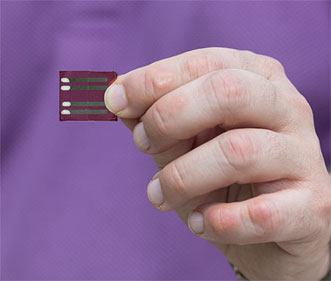LONDON, Ontario, Canada, Sept. 30, 2014 — Gold nanoclusters could improve solar cell performance by more than 10 percent.
A nanocluster made of just 144 gold atoms was used as a building block in the creation of a flexible network of plasmonic antennas that attracted extra light to solar panels. A team from Western University fused the cluster onto the transparent conducting layer of the solar panel.
“Picture an extremely delicate fishnet of gold,” said professor Dr. Giovanni Fanchini. “The fishnet catches the light emitted by the sun and draws it into the active region of the cell.”

Gold nanoclusters form plasmonic antennas that amplify sunlight shining on a solar panel. Courtesy of Western University.
Gold nanoclusters are resilient to oxidization, not easily damaged and scalable to large or small applications. Also, gold is recyclable.
The researchers are now working to incorporate the nanocluster into existing solar cell technology. They are developing a solar panel prototype that could lead to development of highly efficient solar panels and even solar-powered cellphones within the next few years, they said.
“We need sustainable energy in Canada and everywhere else in the world,” Fanchini said. “Solar is already clean. The light of the sun is free. Our challenge now is to make the technology cost-effective and accessible to the most people.”
For more information, visit www.uwo.ca.